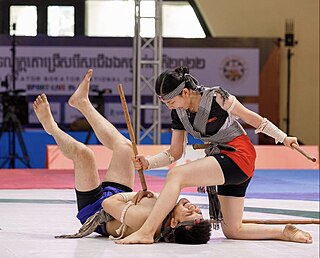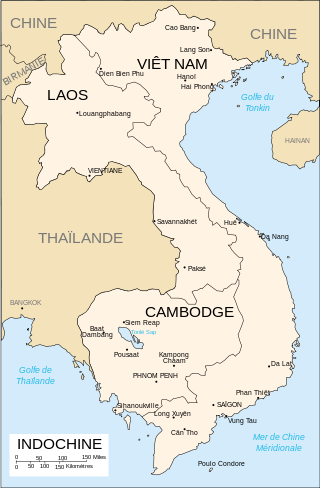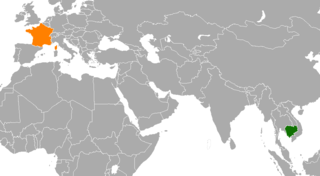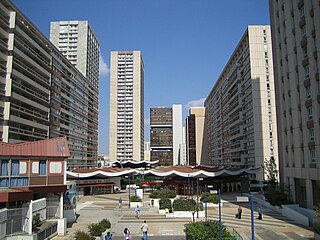| Total population | |
|---|---|
| 80,000 (2020) [1] | |
| Regions with significant populations | |
| Paris, Lyon [2] | |
| Languages | |
| French, Khmer | |
| Religion | |
| Theravada Buddhism | |
| Related ethnic groups | |
| Asians in France |
Cambodians in France consist of ethnic Khmer people who were born in or immigrated to France. The population as of 2020 was estimated to be about 80,000 making the community one of the largest in the Cambodian diaspora. [1] The Cambodian population in France is the most established outside Southeast Asia, with a presence dating to well before the Vietnam War and subsequent Indochina refugee crisis including the horrors of Pol Pot and the Khmer Rouge who took over in Phnom Penh on 17 April 1975. A few numbers of Cambodian people were able to escape and migrate to France before the Khmer Rouge took power in Cambodia as the Cambodian Civil War came to an end and overthrow U.S.-backed military dictatorship of Lon Nol and the Khmer Republic. His brother Lon Non and the other Khmer officials were arrested and executed by the CPK, the Marxist-Leninist dictatorship that seized power in Phnom Penh. 13 days before the Fall of Saigon and the Second Indochina War ended on 30 April 1975.
Cambodian immigration to France began in the later half of the 19th century, when Cambodia became a French protectorate. The first wave of migrants largely consisted of students and workers belonging to the country's elite class, including members of the royal family. [3] During World War I, soldiers and civilians in the French colonial empire were recruited to help with the war effort in Metropolitan France. About 2,000 Cambodians arrived in France during the conflict period. [4]
Following Cambodian independence in 1953, many students and professionals from Cambodia continued to arrive in France. While most of these individuals returned to their home country after a brief sojourn, as the Cambodian Civil War erupted in the late 1960s, most opted to remain permanently in France and sponsored the immigration of family members. With a Cambodian community already established since the early 20th century, the Paris region was the destination of choice for both Cambodian immigrants arriving in France and those studying or working elsewhere in the country. [5]
The majority of Cambodians arrived in France as refugees as a result of their country's heavy turmoil during the latter half of the 20th century. Following the Khmer Rouge takeover in 1975, a small number of Cambodians were able to flee their country and arrive in France with the French government's assistance. [6] A much larger influx of refugees arrived in France during the Cambodian–Vietnamese War that resulted in the collapse of the Khmer Rouge and end of the Cambodian genocide in 1979.
Roughly 50,000 Cambodian refugees arrived in France by 1989. France was an ideal destination for Cambodians who were educated or already had family present in the country, while poorer and uneducated refugees tended to immigrate to the United States and Australia. The final wave of refugees arrived in the late 1990s, when the last refugee camps closed. [7] In contrast to the Vietnamese, Laotian and ethnic Chinese populations in France, Cambodian refugees from conflicts in Indochina arrived relatively later compared to their peers, and had a harder time finding government assistance. [2]
The Cambodian French population is concentrated in Paris and the surrounding Île-de-France region, as well as in Lyon and the Rhône-Alpes region. [2]
In contrast to Cambodian communities in the United States, Canada, and Australia, the Cambodian population in France is on average, more educated, older and has a much higher average income. [8] While the community is still attached to its country of origin in some cultural spheres, Cambodians in France have largely integrated into French society. Cambodians in France have managed to achieve a model minority image; and have income and education levels higher than other Cambodian diaspora communities, although average income levels for the community remain slightly lower than the national average. [9]
Buddhism plays an important role in the community and is seen as a marker of ethnic identity; in contrast, the ability to speak the Khmer language is less emphasized. Though immigrant parents set up language schools for their children soon after migration, many children discontinued their language studies due to the difficulty of learning Khmer grammar and the Sanskrit-based Khmer alphabet. [5]
Numerically, the Khmer are the dominant group among Cambodians in France, but Cambodians of Chinese descent can also be found among the population; though interethnic marriages between Chinese and Khmers were common in Cambodia and remain so in France, the Chinese have tended to organise themselves around the varieties they speak and remain somewhat separate from other Cambodians in France. [10] A small number of Cambodians in France consist of the wives and mixed-race children of French colonisers who repatriated to France between 1955 and 1965; regardless of their ethnicity, many of those used Khmer rather than French as their home language. [11]

Cambodia is the smallest of the three Francophone communities in Southeast Asia, the others being found in Vietnam and Laos. Out of all Asian Francophone nations, Cambodia is where French has declined the most. In 2014, French was spoken by 423,000 people as a foreign language, which is 3% of the country's population and by only 873 people as a mother tongue according to the country's 2008 census.

Bokator or Kun L'Bokator is an ancient Cambodian battlefield martial art. It is one of the oldest fighting systems existing in the world and is recognised as intangible cultural heritage by the UNESCO.

The Bunong is an indigenous ethnic group in Cambodia. They are found primarily in Mondulkiri province in Cambodia. The Bunong is the largest indigenous highland ethnic group in Cambodia. They have their language called Bunong, which belongs to Bahnaric branch of Austroasiatic languages. The majority of Bunong people are animists, but a minority of them follows Christianity and Theravada Buddhism. After Cambodia's independence in 1953, Prince Sihanouk created a novel terminology, referring to the country's highland inhabitants, including the Bunong, as Khmer Loeu. Under the People's Republic of Kampuchea (1979-89), the generic term ជនជាតិភាគតិច "ethnic minorities" came to be in use and the Bunong became referred to as ជនជាតិព្នង meaning "ethnic Pnong". Today, the generic term that many Bunong use to refer to themselves is ជនជាតិដើមភាគតិច, which can be translated as "indigenous minority" and involves special rights, notably to collective land titles as an "indigenous community". In Vietnam, Bunong-speaking peoples are recurrently referred to as Mnong.

Chau Sen Cocsal, also known as Chhum, was a Cambodian civil servant and politician who served as Prime Minister of Cambodia in 1962 and President of the National Assembly twice, in 1962–1963 and 1966–1968.Chhum was awarded the honorary title "Samdech" in 1993 by King Norodom Sihanouk.
Asian diasporas in France or French Asians consist of foreign residents and French citizens originating from Asian countries living in France. French citizens of Asian descent primarily have ancestry from the former French colonies of Indochina, as well as China or Turkey. Other Asian ethnic groups found in France include other West Asians, South Asians, Japanese, and Koreans.
The Laotian diaspora consists of roughly 800,000 people, both descendants of early emigrants from Laos, as well as more recent refugees who escaped the country following its communist takeover as a result of the Laotian Civil War. The overwhelming majority of overseas Laotians live in just three countries: Thailand, the United States, and France.

The Indochina refugee crisis was the large outflow of people from the former French colonies of Indochina, comprising the countries of Vietnam, Cambodia, and Laos, after communist governments were established in 1975. Over the next 25 years and out of a total Indochinese population in 1975 of 56 million, more than 3 million people would undertake the dangerous journey to become refugees in other countries of Southeast Asia, Hong Kong, or China. According to the United Nations High Commissioner for Refugees, 250,000 Vietnamese refugees had perished at sea by July 1986. More than 2.5 million Indochinese were resettled, mostly in North America, Australia, and Europe. More than 525,000 were repatriated, either voluntarily or involuntarily, mainly from Cambodia.

Cambodia–France relations are the bilateral relations between the Kingdom of Cambodia and the French Republic. Cambodia was a protectorate of France from 11 August 1863 to 9 November 1953. King Norodom approached the French in 1861, in an attempt to stop neighbors Thailand and Vietnam from swallowing Cambodia's land.

The Quartier asiatique, also called Triangle de Choisy or Petite Asie is the largest commercial and cultural center for the population of Asian origin of Paris. It is located in the southeast of the 13th arrondissement in an area that contains many high-rise apartment buildings. Despite its status as a "Chinatown", the neighborhood also contains significant Vietnamese, Laotian and Cambodian populations.
George Groslier was a French polymath who – through his work as a painter, writer, historian, archaeologist, ethnologist, architect, photographer and curator – studied, described, popularized and worked to preserve the arts, culture and history of the Khmer Empire of Cambodia. Born in Phnom Penh to a French civil servant – he was the first French child ever born in Cambodia – Groslier was taken by his mother to France at the age of two and grew up in Marseille. Aspiring to become a painter, he tried but failed to win the prestigious Prix de Rome. Shortly afterwards, he returned to Cambodia, on a mission from the Ministry of Education. There he met and befriended a number of French scholars of traditional Cambodian culture. Under their influence, he wrote and published, in France in 1913, his initial book on this subject: Danseuses Cambodgiennes – Anciennes et Modernes. It was the very first scholarly work ever published in any language on Cambodian dance. He then returned to Cambodia, traveling the length and breadth of the country to examine its ancient monuments and architecture. From this experience came his book A l'ombre d 'Angkor; notes et impressions sur les temples inconnus de l'ancien Cambodge. In June 1914, Groslier enlisted in the French army and was employed as a balloonist in the early part of World War I. It was during this time that he met and married sportswoman Suzanne Cecile Poujade; they eventually had three children.
Pauline Dy Phon was a Cambodian botanist who specialized in the flora of Southeast Asia.
A neak ta is a Cambodian ancestral or tutelary deity, believed locally to watch over people, places, and things, as long as they are paid proper respect.

Wat Moha Leap, or vatt Mahā Lābh (វត្តមហាលាភ), is a century-old Buddhist pagoda in Kampong Cham province, Cambodia. It is the country's last standing temple with a wooden structure.

Wat Vihear Suor is a Theravada Buddhist temple located in Kandal Province, Cambodia. It was built on an older pre-Buddhist cult site belonging to the Angkor era.
The Embassy of France in Cambodia is the primary diplomatic mission of the French Republic to the Kingdom of Cambodia. It is located in the capital Phnom Penh. It is known for the role it played as a place of refuge for foreigners and at-risk Cambodians after the Khmer Rouge takeover for several days until foreigners were forced to go to Thailand while the regime forced Cambodians to stay in the country.

Somdach Veang Thiounn was a Cambodian state official of the Khmer nobility during the French protectorate of Cambodia who had a lasting influence on Khmer historiography through the Cambodian Royal Chronicles. While he has been described as the shogun of the French protectorate and a "comprador feudalist", others have praised his long service to the Kingdom of Cambodia, as "the epitome of the colonial subject who quickly saw how to turn the new regime to an advantage":

Sra peang is a rice wine stored in earthen pots and indigenous to several ethnic groups in Cambodia, in areas such as Mondulkiri or Ratanakiri. It is made of fermented glutinous rice mixed with several kinds of local herbs. The types and amount of herbs added differ according to ethnic group and region. This mixture is then put into a large earthenware jug, covered, and allowed to ferment for at least one month. The strength of this alcoholic beverage is typically 15 to 25 percent alcohol by volume.
Baksei Chamkrong is a legendary monarch of Cambodia, whose life and rule are known from the Cambodian Royal Chronicles. Despite a lack of historicity, the narrative of his epic has had a lasting influence on Cambodian culture and politics.

Cambodia House is a student housing and cultural center located in the Cité internationale universitaire de Paris, in the 14th arrondissement. The center was built by French architect Alfred Audoul in the neoclassical style; it is ornamented with Khmer decorative elements. The Cambodia House was inaugurated in 1957, four years after Cambodia's independence.
Hunting is a popular recreational pursuit, a tourist activity in Cambodia, but mostly still a livelihood for many people in Cambodia.